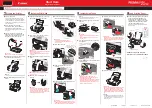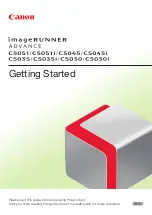
3
Using
a
TCP/IP
Network
3-56
IPSec Settings
IPSec Settings
If you install the optional IPSec Board to the machine, you can use IPSec communications by setting
<Use IPSec> to [On] in the IPSec Settings screen on the touch panel display of the machine.
IPSec is a protocol for ensuring the security of IP packets sent and received over an IP network by
protecting it from threats such as theft, modification, and impersonation. IPSec is applied for TCP
packets, UDP (User Datagram Protocol) packets, and ICMP (Internet Control Message Protocol)
packets. The reason why IPSec is superior to other security protocols is that since it adds security
functions to IP, the basic protocol of the internet, it does not depend on the application software and
network configuration.
This section describes the procedure for creating a security policy to set IPSec communications,
using the control panel of the machine. A security policy registers the settings for IPSec, such as the
packets to process with IPSec, and the algorithm to use for authentication and encryption. A logical
connection established for traffic by conducting negotiations according to an IPSec security policy is
called an IPSec SA (Security Association).
The features of the IPSec used by the machine are as follows.
Remarks
[IPSec Settings] is only displayed on the TCP/IP
Settings screen if the optional IPSec Board is installed
after installing the optional Expansion Bus.
Communication Mode
Since the IPSec of the machine only supports the transport mode, authentication and encryption is
only applied to the data part of the IP packets.
Authentication and Encryption Method
At least one of the following methods must be set for the machine. You cannot set both methods at
the same time.
AH (Authentication Header)
A protocol for certifying authentication by detecting modifications to the communicated data,
including the IP header. The communicated data is not encrypted.
Acesst 1.0 6251194
Summary of Contents for iR3245
Page 2: ......
Page 7: ...chapter 1 Before You Start...
Page 15: ...1 Before You Start Using E Mail I Fax 1 9 Using E Mail I Fax...
Page 18: ...1 Before You Start 1 12 Sending Data Sending Data...
Page 29: ...chapter 2 Settings Common to the Network Protocols...
Page 53: ...chapter 3 Using a TCP IP Network...
Page 149: ...3 Using a TCP IP Network FTP Server Settings 3 97 FTP Server Settings...
Page 171: ...chapter 4 Using a NetWare Network Windows...
Page 194: ...4 Using a NetWare Network Windows 4 24 Setting Up a Computer as a File Server...
Page 195: ...chapter 5 Using a NetBIOS Network...
Page 206: ...5 Using a NetBIOS Network 5 12 Printer Connection Method Printer Connection Method...
Page 222: ...5 Using a NetBIOS Network 5 28 Samba UNIX Linux Mac OS X...
Page 223: ...chapter 6 Using an AppleTalk Network Macintosh...
Page 228: ...6 Using an AppleTalk Network Macintosh 6 6 Setting Up a Computer for Printing...
Page 229: ...chapter 7 Troubleshooting...
Page 252: ...7 Troubleshooting 7 24 IEEE802 1X Authentication Problems and Remedies...
Page 253: ...chapter 8 Appendix...
Page 287: ......
















































